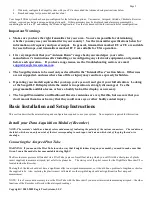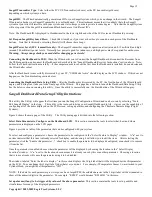
Copyright © 2003-2005 Eagle Tree Systems, LLC
Page 6
sinkrate, the variometer will start to sound, as described in the “Variometer” section above. Pressing up/down
arrows changes this parameter.
•
“Vario Climbrate” – this setting controls the minimum climbrate. When you ascend at a rate greater than this climbrate, the
variometer will start to sound, as described in the “Variometer” section above. Pressing up/down arrows changes this
parameter.
•
“Vario Freq Shift” – This setting changes the amount the pitch changes as the climbrate increases/decreases. If you are not
hearing enough change, increase this parameter, and vice versa for too much frequency change.
•
“Total Energy %” – this adjusts the scaling of the Total Energy Compensation calculation. 100% means that Kinetic Energy
is converted into Potential Energy directly, i.e., any change in airspeed is assumed to directly negate any change in altitude.
Less than 100% reduces the degree which airspeed change affects Total Energy, and increasing it above 100% increases the
amount.
Ready for Action!
Now that you have completed basic installation and configuration of the Seagull system, it’s time to actually use it!
Power on your model as you normally would, turning on your radio transmitter before powering up the model. The Recorder’s LED
should blink normally (one flash repeating) after powering up the model.
NOTE: Always wait 15 seconds after powering down your Recorder, before powering it back on. This will ensure that the
Recorder and transmitter start properly.
Next, power on your Dashboard. Since the Dashboard calibrates several of the parameters on powerup, always turn on your model
first, then turn on your Dashboard (or turn the Dashboard power off and on after you model is turned on).
At this point, the Dashboard should display live data. By default, page one of the data displayed contains Airspeed, Altitude,
Variometer climbrate (TE compensated), and Receiver voltage. Page two of the data displayed contains signal strength, received
packet percentage, and raw climbrate (non-TE compensated). If the Dashboard displays “No Signal”, consult the Troubleshooting
section below.
Once the Seagull system is communicating, consider how you will mount and use the Dashboard. The Dashboard can be mounted
to your radio transmitter, using the supplied plastic clip with adhesive. Just remove the adhesive backing from the clip, mount the
clip on the back of the dashboard, and clip the ring around your radio’s antenna. You can further stabilize the dashboard with a strip
of Velcro on the dashboard’s bottom. Or, just hand the dashboard your crew or buddy to monitor your run, or just place it in your
shirt pocket.
It is a very bad idea to take your eyes off your model during operation!
DON’T FORGET TO “ANTENNA DOWN” RANGE CHECK YOUR MODEL AFTER INSTALLATION, AS DESCRIBED
IN YOUR RADIO MANUAL!
Adjusting the Variometer
The Averaging Period, Sinkrate, and Total Energy Compensation percentage should be adjusted depending on wind conditions, plane
geometry, etc., so that the unit is silent when you are flying in still air but descending normally at your plane’s standard sinkrate.
See the above section for instructions on how to change these parameters, even while the plane is flying.
Typically, you would start with a very small Variometer Average Seconds (perhaps 0.2), and a sinkrate of perhaps 150. If the unit
“sqawks” or “honks” a lot when flying outside of thermals, start gradually increasing the average seconds until it doesn’t sqawk.
Then, adjust the Minimum Sinkrate parameter until the unit just barely does not make a constant tone as you descend due to gravity
when flying level. We recommend that the above adjustments be made with the Total Energy percentage set to 0%.
The total energy % should be adjusted (after doing the above adjustments) so that “stick thermals” are minimized. We recommend
starting at 100%, then adjusting the value up or down, so that you can pull back on the elevator and not hear lift tones.
Happy flying!





















